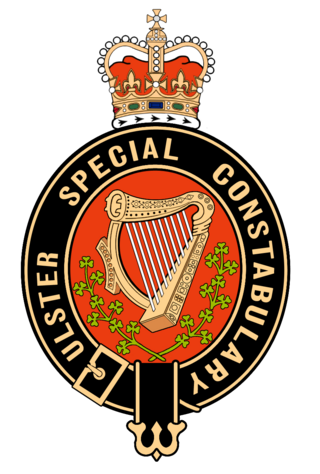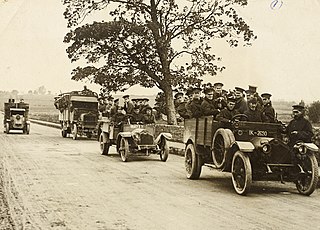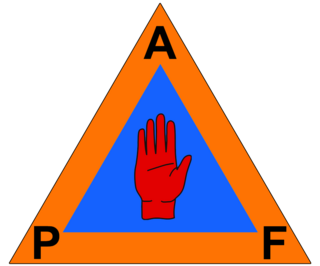Related Research Articles

The Irish Republican Army was an Irish republican revolutionary paramilitary organisation. The ancestor of many groups also known as the Irish Republican Army, and distinguished from them as the "Old IRA", it was descended from the Irish Volunteers, an organisation established on 25 November 1913 that staged the Easter Rising in April 1916. In 1919, the Irish Republic that had been proclaimed during the Easter Rising was formally established by an elected assembly, and the Irish Volunteers were recognised by Dáil Éireann as its legitimate army. Thereafter, the IRA waged a guerrilla campaign against the British occupation of Ireland in the 1919–1921 Irish War of Independence.

The Royal Ulster Constabulary (RUC) was the police force in Northern Ireland from 1922 to 2001. It was founded on 1 June 1922 as a successor to the Royal Irish Constabulary (RIC) following the partition of Ireland. At its peak the force had around 8,500 officers, with a further 4,500 who were members of the RUC Reserve.

The Irish War of Independence or Anglo-Irish War was a guerrilla war fought in Ireland from 1919 to 1921 between the Irish Republican Army and British forces: the British Army, along with the quasi-military Royal Irish Constabulary (RIC) and its paramilitary forces the Auxiliaries and Ulster Special Constabulary (USC). It was part of the Irish revolutionary period.

The Royal Irish Constabulary was the police force in Ireland from 1822 until 1922, when all of the country was part of the United Kingdom. A separate civic police force, the unarmed Dublin Metropolitan Police (DMP), patrolled the capital and parts of County Wicklow, while the cities of Derry and Belfast, originally with their own police forces, later had special divisions within the RIC. For most of its history, the ethnic and religious makeup of the RIC broadly matched that of the Irish population, although Anglo-Irish Protestants were overrepresented among its senior officers.

The Ulster Special Constabulary was a quasi-military reserve special constable police force in what would later become Northern Ireland. It was set up in October 1920, shortly before the partition of Ireland. The USC was an armed corps, organised partially on military lines and called out in times of emergency, such as war or insurgency. It performed this role most notably in the early 1920s during the Irish War of Independence and the 1956–1962 IRA Border Campaign.
Events from the year 1920 in Ireland.

The Short Strand is a working class, inner city area of Belfast, Northern Ireland. It is a mainly Catholic and Irish nationalist enclave surrounded by the mainly Protestant and unionist East Belfast.

This is a timeline of the Irish War of Independence of 1919–21. The Irish War of Independence was a guerrilla conflict and most of the fighting was conducted on a small scale by the standards of conventional warfare.

Joseph McKelvey was an Irish Republican Army officer who was executed during the Irish Civil War without trial or court martial. He participated in the Anti-Treaty IRA's repudiation of the authority of the Dáil Éireann, the civil government of the Irish Republic declared in 1919 in March 1922, and was elected to the IRA Army Executive. In April 1922, he helped command the occupation of the Four Courts in defiance of the new Irish Free State. This action helped to spark the civil war, between pro- and anti-treaty factions. McKelvey was among the most hardline of the republican side and, briefly in June 1922, became IRA Chief of Staff.

The Protestant Action Force (PAF) was a front group used by Ulster loyalist paramilitaries in Northern Ireland when claiming responsibility for a number of attacks during the Troubles. First used in 1974, attacks by individuals claiming to be members of the PAF killed at least 41 Catholic civilians. The PAF was most commonly used by members of the Ulster Volunteer Force (UVF). All of the attacks claimed by the PAF in Armagh and Tyrone counties from 1974 to 1976 have been linked to the Glenanne gang, which was a group consisting of members of the UVF Mid-Ulster Brigade along with rogue Ulster Defence Regiment (UDR) soldiers and Royal Ulster Constabulary (RUC) police officers. A six-year period of no attacks claimed by the PAF ended in 1982; during the 1980s, the PAF claimed 15 attacks in the Belfast area and two in County Armagh. UDR soldiers were convicted of two attacks in Armagh. The PAF claimed its last attacks in the early 1990s, all of which were in north Armagh and were alleged to involve members of the security forces.

John William Nixon, MBE, was a unionist politician and police leader in Northern Ireland who was alleged to be responsible for several sectarian atrocities, including the McMahon killings and the Arnon Street killings. It was widely believed that Nixons "murder gang" within the Royal Irish Constabulary (RIC) hunted down and murdered Catholics as reprisals for the killing of police.
Roger McCorley was an Irish republican activist.
The McMahon killings or the McMahon murders occurred on 24 March 1922 when six Catholic civilians were shot dead at the home of the McMahon family in Belfast, Northern Ireland. A group of police officers broke into their house at night and shot all eight males inside, in an apparent sectarian attack. The victims were businessman Owen McMahon, four of his sons, and one of his employees. Two others were shot but survived, and a female family member was assaulted. The survivors said most of the gunmen wore police uniform and it is suspected they were members of the Ulster Special Constabulary (USC). It is believed to have been a reprisal for the Irish Republican Army's (IRA) killing of two policemen on May Street, Belfast the day before.
Bloody Sunday or Belfast's Bloody Sunday was a day of violence in Belfast, Northern Ireland on 10 July 1921, during the Irish War of Independence. The violence erupted one day before a truce began, which ended the war in most of Ireland. With the truce nearing, police launched a raid against republicans, but were ambushed by the Irish Republican Army (IRA) and an officer was killed. In retaliation, Protestant loyalists attacked Catholic enclaves in west Belfast, burning homes and businesses. This sparked rioting and gun battles between Protestants and Catholics, including paramilitaries. There were also gun battles between republicans/nationalists and the police, and some police patrols fired indiscriminately at Catholic civilians. Seventeen people were killed or fatally wounded on 10 July, and a further three were killed or fatally wounded before the truce began at noon on 11 July. At least 100 people were wounded. About 200 houses were destroyed or badly damaged, most of them Catholic homes, leaving 1,000 people homeless. See: The Troubles in Northern Ireland (1920–1922).

The Donegall Street bombing took place in Belfast, Northern Ireland on 20 March 1972 when, just before noon, the Provisional IRA detonated a car bomb in Lower Donegall Street in the city centre when the street was crowded with shoppers, office workers, and many schoolchildren.

The sack of Balbriggan took place on the night of 20 September 1920, during the Irish War of Independence. Auxiliary members of the Royal Irish Constabulary known as "Black and Tans" went on a rampage in the small town of Balbriggan, County Dublin, burning more than fifty homes and businesses, looting, and killing two local men. Many locals were left jobless and homeless. The attack was claimed to be revenge for the shooting of two police officers in Balbriggan by the Irish Republican Army (IRA). It was the first major 'reprisal' attack against an Irish town during the conflict. The sack of Balbriggan drew international attention, leading to heated debate in the British parliament and criticism of British government policy in Ireland.
Seamus Woods commanded a division of the Irish Republican Army (IRA) during a period of intense conflict and was a senior leader of the newly formed Irish Free State army.

The Troubles of the 1920s was a period of conflict in what is now Northern Ireland from June 1920 until June 1922, during and after the Irish War of Independence and the partition of Ireland. It was mainly a communal conflict between Protestant unionists, who wanted to remain part of the United Kingdom, and Catholic Irish nationalists, who backed Irish independence. During this period, more than 500 people were killed in Belfast alone, 500 interned and 23,000 people were made homeless in the city, while approximately 50,000 people fled the north of Ireland due to intimidation. Most of the victims were Nationalists (73%) with civilians being far more likely to be killed compared to the military, police or paramilitaries.
References
- Coogan, Tim Pat (2002). Michael Collins: The Man Who Made Ireland. New York: Palgrave Macmillan. ISBN 978-0-312-29511-0.
- Lynch, Robert (2006). The Northern IRA and the early years of partition, 1920–1922. Irish Academic Press. ISBN 978-0-7165-3378-8.
- Parkinson, Alan F. (2004). Belfast's Unholy War: The Troubles of the 1920s. Dublin: Four Courts Press.